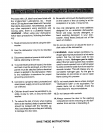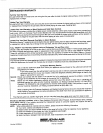
Soft Water Etching
If the cloudy film is not removed after soaking in
vinegar (previous procedure), then the condition You can help save energy if you:
is etching. This permanent film occurs in unusual
conditions under which the surface of the glass is 1. Wash full loads. Running a half-filled dish-
pitted or eroded. It is permanent, washer uses the same amount of electricity
and hot water as a fully loaded machine.
In the beginning stages, etching may be identified 2. Do not pre-rinse normally soiled dishes. Se-
by a"rainbow" look--shades of blue, purple, brown lect the correct cycle for the load and use the
or pink may be seen when the glass is held at an recommended amount of detergent for good
angle to the light. In advanced stages the surface washing results without hand rinsing.
of the glassware appears frosted, spotted or 3. Load correctly for best washing results. Incor-
cloudy, rect loading may cause poor washing and the
need to prewash all or part of the load.
Certain types of glassware will etch in any dish- 4. Use the Light cycle when dishes are lightly
washer with the combination of soft water (espe- soiled. It uses less hot water and energy than
cially mechanically softened), an excessive amount other cycles.
of detergent, heat and prerinsing. There is no 5. Most models - fan dry dishes (without heat)
relationship to the cost or quality of the glass, when you don't need them dried quickly. Allow
longer drying times (overnight).
To prevent: 6. Use your dishwasher during off-peak hours.
Local utilities recommend this to avoid heavy
1. Adjust the amount of detergent to the degree usage of energy at certain times of the day.
of water hardness. (See p. 7.) Check with your utility company to see if off-
2. Lower the water temperature to 120°F. (See peak rates exist.
p. 4.)
3. Avoid using the Heat Dry drying option.
4. Do not manually pre-rinse dishes before load-
ing in dishwasher. Pre-rinsing prior to loading The interior is normally self-cleaning. Occasion-
to remove all food soil aggravates etching, ally check the bottom of the dishwasher tub and
clean out pieces of food which may collect there.
Rust
Sometimes the dishes or the interior of the dish- Periodically clean the bottom edge of the dish-
washer may turn a brown, red or black color if iron washer door liner. Food and liquids drip onto this
or manganese is in the water. To remove discol- area when the dishwasher is loaded.
oration from the dishwasher interior, dishes and
glassware (no metal items): If you notice an odor in your dishwasher, it may be
due to a strong "chemical" or chlorine odor from
1. Select a rust removing compound, such as the dishwasher detergent. Using a different deter-
RoVer Rust Remover. It is available from gent, especially a lemon scented one, will prob-
dealers by using Part No. 057961. ably eliminate the odor. In some instances the
2. Start empty dishwasher on Rinse & Hold or smell of the rinse aid may be strong. Purchase a
rinse portion of the cycle. During fill, open the fresh package and see if it is better. Lastly, if the
door and add 1/2 cup RoVer Rust Remover to dishwasher is run only every couple of days, an
the water. Allow the dishwasher to complete odor may develop. Use the Rinse & Hold cycle
the cycle, daily to remove any food soil that may cause an
3. Follow with a detergent wash. odor.
The only permanent solution is to install special
filters which can remove iron and manganese
from the water.
12


















